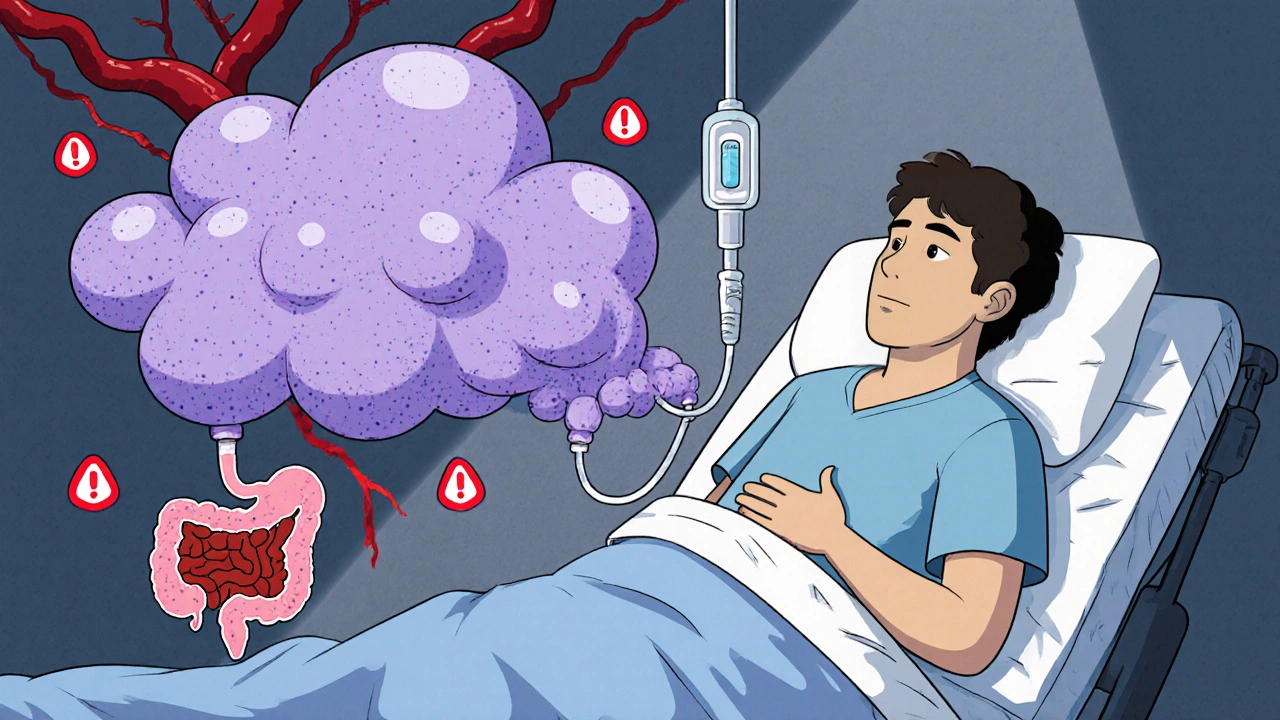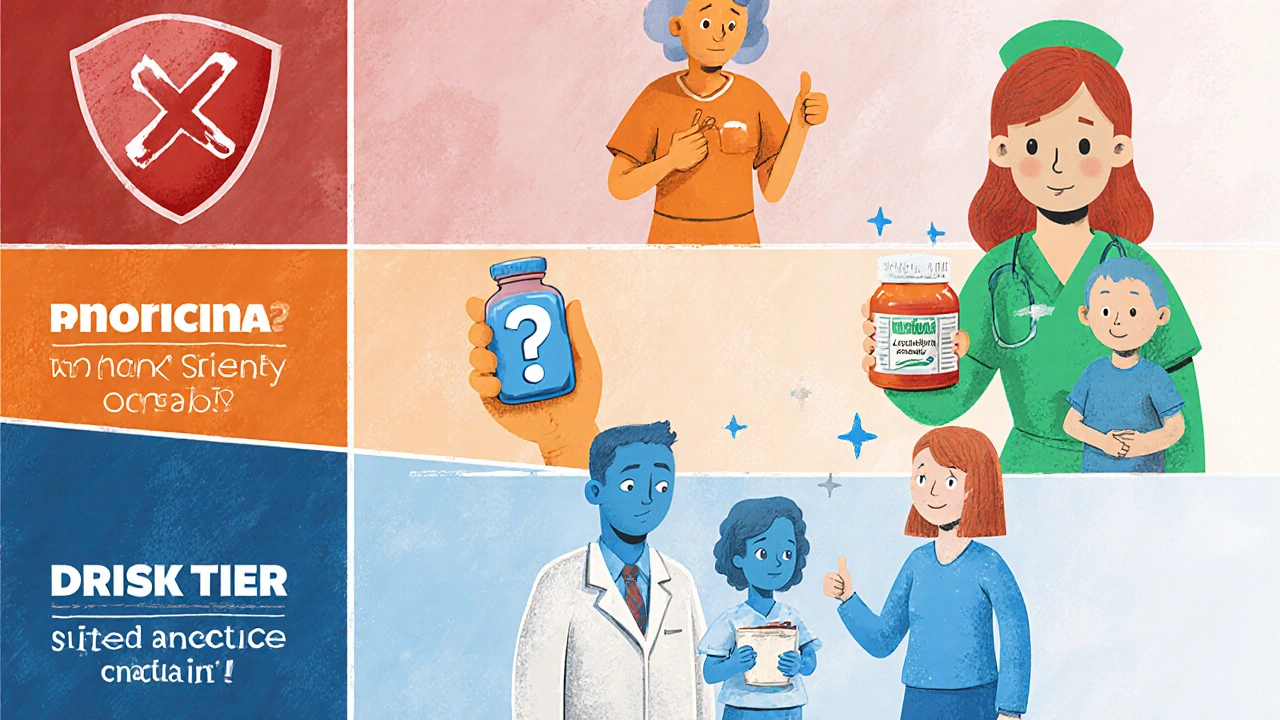Probiotic Risk Assessment Tool
How to use this tool
Select patient characteristics to determine the appropriate probiotic risk tier and clinical recommendations based on current guidelines.
Recommendations
When it comes to infection risk, probiotics demand careful consideration, especially for people taking immunosuppressants. In the last decade, doctors have reported cases where otherwise harmless microbes crossed a weakened gut barrier and caused serious bloodstream infections. This guide walks you through how these products work, which patients are most vulnerable, and what practical steps clinicians and patients can take to stay safe.
What are probiotics?
Probiotics are live microorganisms that, when taken in adequate amounts, provide a health benefit to the host. The World Health Organization defined them in 2001, and today they are sold in thousands of formulations worldwide. The most common strains are Lactobacillus (found in 73% of products), Bifidobacterium (68%) and the yeast Saccharomyces boulardii (32%). They work by competing with pathogens, producing antimicrobial substances, strengthening the intestinal barrier, and modulating immune signals.
What are immunosuppressants?
Immunosuppressants are drugs that deliberately dampen the immune system. They are essential after organ transplants, for autoimmune diseases like rheumatoid arthritis, and during chemotherapy. Common classes include calcineurin inhibitors (cyclosporine, tacrolimus), antimetabolites (mycophenolate mofetil), corticosteroids (prednisone) and biologics such as anti‑CD20 antibodies (rituximab). By lowering immune surveillance, these agents make it harder for the body to clear any microbes that manage to cross the gut lining.
How probiotics can become a danger in immunosuppressed patients
In healthy individuals, the gut barrier and a robust immune response keep probiotic microorganisms where they belong-inside the intestinal lumen. Immunosuppressed patients, however, may have a compromised barrier and an impaired ability to kill translocated bacteria or yeast. When live microbes enter the bloodstream, they can cause sepsis, fungemia, abscesses, endocarditis or pancreatitis. A 2021 systematic review found bloodstream infection rates of 0.01‑0.1% in high‑risk groups, with the highest fatality seen when Saccharomyces boulardii was involved (22% case‑fatality). Central venous catheters, severe neutropenia (ANC < 500 cells/µL) and the early post‑transplant period are the strongest predictors of infection.

Evidence by patient population
Risk is not uniform across all immunosuppressed groups. Below is a snapshot of the most relevant data.
- Liver transplant recipients: A 2022 meta‑analysis showed probiotics reduced bacterial infections by 34% with no rise in serious adverse events.
- Bone marrow transplant patients: A 2020 study reported a 4.2‑fold increase in probiotic‑related bacteremia compared with non‑users.
- HIV patients: Those with CD4 > 200 cells/µL have minimal added risk, while CD4 < 100 cells/µL sees a 3.8‑fold rise in fungemia.
- Chemotherapy patients during myelosuppression: 87% of major U.S. cancer centers advise avoiding probiotics entirely.
- Solid organ transplant within 3 months: Highest risk tier; most guidelines consider probiotic use an absolute contraindication.
Guidance from professional societies
The Infectious Diseases Society of America (IDSA) 2023 guidance proposes a four‑tier risk assessment:
- Category 1 (highest risk): Neutropenia < 500 cells/µL, recent stem‑cell transplant, presence of a central line - absolute contraindication.
- Category 2 (moderate risk): Solid organ transplant ≤ 3 months, severe autoimmune disease on multiple agents - probiotic only after infectious disease consultation.
- Category 3 (lower risk): Stable autoimmune disease on a single drug, CD4 > 200 - selective strains (e.g., Lactobacillus plantarum 299v) may be considered.
- Category 4 (low risk): No immunosuppression - standard probiotic use.
In moderate‑risk patients, IDSA recommends weekly blood cultures for the first two weeks of probiotic therapy and immediate discontinuation if fever > 38.3 °C develops.
Practical implementation for clinicians
When a probiotic is prescribed or recommended, follow these steps:
- Document the exact strain: include the strain identifier (e.g., Lactobacillus rhamnosus GG ATCC 53103). Different strains of the same species have distinct safety profiles.
- Choose single‑strain over multi‑strain products: a 2022 study showed a 63% lower translocation risk with single‑strain formulations.
- Avoid Saccharomyces boulardii in anyone with a central venous catheter or severe neutropenia.
- Monitor closely: baseline CBC, weekly cultures for 14 days if risk tier 2, and educate patients to report any fever or chills immediately.
- Re‑evaluate necessity: many benefits of probiotics (e.g., preventing antibiotic‑associated diarrhea) can be achieved with diet, pre‑biotics or post‑biotics once the high‑risk period passes.

Emerging alternatives: post‑biotics and dead‑cell products
Post‑biotics are in‑activated microbial cells or metabolites that can confer health benefits without the risk of live‑organism infection. A phase 2 trial (NCT04873011) demonstrated a 40% reduction in C. difficile infection among immunocompromised patients without any adverse events. These products are gaining traction in transplant centers as a safer way to modulate the gut microbiome.
Regulatory landscape and market realities
Globally, the probiotics market was valued at $52.78 billion in 2022 and is projected to grow 8.3% annually through 2030. However, most products are classified as dietary supplements, not drugs, meaning the FDA does not require pre‑market safety testing for high‑risk groups. The European Food Safety Authority has rejected 95% of health claims for probiotics over the past decade, citing insufficient evidence. In July 2023 the FDA issued a safety communication demanding warning labels on any probiotic containing Saccharomyces boulardii for immunocompromised patients.
Hospital formularies are catching up: a 2023 survey of U.S. academic medical centers found 62% now have specific probiotic protocols for immunosuppressed patients, up from 28% in 2018.
Bottom‑line recommendations
For clinicians, the key is to assess risk before recommending any live‑culture supplement. Use the IDSA tier system, prefer single‑strain products, avoid Saccharomyces boulardii in high‑risk patients, and consider post‑biotic alternatives when gut health support is needed. For patients, never start a probiotic on your own if you are on high‑dose steroids, recent transplant medication, or have a central line-talk to your doctor first.
| Tier | Typical Scenarios | Probiotic Recommendation | Monitoring |
|---|---|---|---|
| Category 1 | Neutropenia <500 cells/µL, stem‑cell transplant <30 days, central line | Absolute contraindication | None - avoid |
| Category 2 | Solid‑organ transplant ≤ 3 months, multi‑agent autoimmune therapy | Only after infectious‑disease consult; single‑strain only | Weekly blood cultures for 14 days; stop if fever >38.3 °C |
| Category 3 | Stable autoimmune disease on single drug, CD4 > 200 | Selective strains (e.g., Lactobacillus plantarum 299v) | Baseline CBC; symptom watch |
| Category 4 | No immunosuppression | Standard probiotic use | Standard care |
Can I take probiotic supplements after a kidney transplant?
In the first three months post‑transplant, most guidelines label live‑culture probiotics as an absolute contraindication because of the high risk of bloodstream infection. After this period, a single‑strain product may be considered only with infectious‑disease approval.
Are there any probiotic strains that are safe for patients on steroids?
Steroid monotherapy places patients in Category 3 for most risk models. Strains such as Lactobacillus plantarum 299v and Bifidobacterium longum have the most safety data and may be used with doctor supervision.
What is the difference between a probiotic and a post‑biotic?
Probiotics are live microorganisms; post‑biotics are inactivated cells or metabolites that still provide health benefits but cannot replicate or cause infection.
Should I stop my probiotic if I develop a fever while on chemotherapy?
Yes. Fever > 38.3 °C while on a high‑risk regimen (neutropenia) triggers immediate discontinuation and blood culture evaluation.
Do probiotic‑containing foods (like yogurt) pose the same risk as supplements?
Fermented foods usually contain lower colony counts and a mix of strains, but the risk still exists for severely immunocompromised patients. Many clinicians advise avoiding them during the highest risk periods.


Paul Luxford
If you're on a strong immunosuppressant, think twice before popping a probiotic.
Manoj Kumar
Probiotics feel like a quick fix, but when your immune system is on a leash they can turn into a liability. The gut barrier in a transplant patient is already fragile, and a live culture can slip through that weakened wall. Studies from the last few years show that Saccharomyces boulardii, despite its popularity, accounts for a disproportionate share of probiotic‑related sepsis. Even Lactobacillus, which we usually think of as harmless, has been isolated from bloodstream infections in neutropenic patients. The IDSA tier‑system that the guide mentions is a solid framework; Category 1 patients should never see a live‑culture supplement. For Category 2 folks, a pre‑approval from infectious disease is not just bureaucracy-it’s a safety net that can catch rare translocation events. When you do need gut support, single‑strain products with documented strain IDs lower the odds of unintended colonisation. Post‑biotics are emerging as a pragmatic alternative because they deliver metabolites without the risk of live organisms crossing the gut. A phase‑2 trial cited in the article reported a 40 % drop in C. difficile infection among immunocompromised patients taking a post‑biotic, and no adverse events were noted. From a practical standpoint, always check the label for Saccharomyces and steer clear if a central line is in place. Baseline CBCs and weekly cultures during the first two weeks of any probiotic trial are cheap insurance. If a fever spikes above 38.3 °C, stop the supplement immediately and run cultures-this is non‑negotiable. Nutritionists also remind us that a high‑fiber diet can foster beneficial microbes without the live‑culture gamble. Finally, keep an eye on regulatory updates; the FDA’s warning label push means manufacturers might start flagging high‑risk groups soon. Bottom line: live probiotics are not universally safe, and a careful risk assessment beats a blanket recommendation every time.
Hershel Lilly
For patients on steroids alone, the risk tier lands in Category 3, which means you can consider strains like Lactobacillus plantarum 299v under supervision. The evidence suggests that single‑strain products have about a 60 % lower chance of translocation compared to multi‑strain mixes. Documenting the exact strain ID on the chart helps the pharmacy team flag any potential issues. Also, avoid any product that contains Saccharomyces if you have a central venous catheter, even if you feel fine.
Carla Smalls
Good rundown-makes it clear when to pause the probiotics and when a safer post‑biotic might fit.
Monika Pardon
Ah yes, because the pharma lobby surely wants us to trust that “post‑biotic” is just a fancy buzzword, not a loophole to keep profits flowing while we pretend safety is a checklist.
Rhea Lesandra
Exactly, and the strain‑specific labeling isn’t just red tape; it’s the breadcrumb trail that lets clinicians trace back any adverse event. In practice, I’ve seen a hospital switch to a single‑strain Lactobacillus protocol after a near‑miss infection, and the outcomes improved dramatically.
Kasey Marshall
Yep, keep the probiotic stash locked away until your doc signs off; otherwise you’re gambling with bloodstream infections.
Dave Sykes
Bottom line: if you’re on any high‑dose immunosuppressant, hold off on live probiotics, get a consultation, and consider post‑biotic or diet changes instead-no excuses.